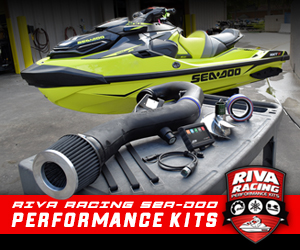First, let’s start with the good news: personal watercraft sales are up across the board. All three manufacturers are experiencing a swell in new unit sales that hasn’t been paralleled since numbers began to tick upwards in mid-2012; as a report from Boating Industry claims that the PWC industry has experienced a “10-percent monthly year-over-year sales growth throughout 2012.”
Some investigating by The Watercraft Journal has garnered some pretty substantial numbers, particularly on behalf of Yamaha’s VX series WaveRunners in all of their variations. Equally impressive, we’ve heard ruminations that the new Sea-Doo Spark has accounted for a gain of 7-percent additional market share. If true, that would push Sea-Doo’s existing 49.5-percent market dominance closer to 56.5-percent.
Even Kawasaki is reporting an increase in sales, with regional reps telling our contacts that literally all 310-horsepower Ultra units have been sold (that’s not to say you can’t buy one from a dealer). Even the 12-year-old STX-15F retains a position in the Top 10 of popular units – thanks to a generous amount of discounts and incentives.
But all of this good news in sales leaves a few questions, namely what holes appear in each manufacturer’s lineup? What ski is Sea-Doo offering that Yamaha lacks? Or what can Kawasaki do to broaden its appeal to a wider purchasing demographic? As always, The Watercraft Journal believes its got the answers thanks to some inside knowledge, a strong understanding of the manufacturing process and some good ol’ fashioned guesswork.
This latest edition of “Vicious Rumors and Vile Gossip” will illustrate some of the easiest gaps in all three OEM’s product lineups to be filled cheaply and easily. That’s right, these machines can be built with literally minimal investment from each manufacturer and reach the broadest audience possible.
Kawasaki Ultra LX SE JetSki
While we would love to use this opportunity to present our long-winded plans for the glorious return of the STX-R name as a 310-horsepower Kawasaki STX-15R, we know a fully-loaded naturally aspirated Ultra LX is a little more likely. Why? Because as representatives from both Yamaha and Sea-Doo can attest, buyers today are big on comfort and fuel economy.
Sadly, the current Ultra LX is thin on both accounts. The standard Ultra LX is pretty plain at best, touting some decent paint and graphics as well as the brand’s scalloped LX seat and retractable swim step. Yet, the finer Ultra 310LX is chocked full of goodies like cruise control, No Wake mode, electronic trim control and the industry’s only on board sound system, Jetsound.
All that is needed to develop the Ultra LX Special Edition (SE) is stripping the 310LX of its supercharger and intercooler. The LX SE should retain all of the creature comforts of the 310LX but without the gas guzzling thirst of the monster powerplant, opening up Kawasaki to more mileage-conscious riders who still want the refinement of a luxury craft.
Sea-Doo GTI Limited 215
As mentioned earlier and in previous articles here on The Watercraft Journal, Spark sales are good, but some are reporting gains at the cost of GTI sales. Sea-Doo’s GTI segment is still their best selling as the GTI range is so varied. From the rental-friendly GTS to the lightly optioned GTI SE 130 to the top-of-the-line GTI Limited 155, Sea-Doo’s Recreation line is a buffet of possibilities.
And the versatile GTI hull is a hit with casual riders, beginners, long distance cruisers and even racers, as the GTI sheds its “nice guy” visage with the rip snortin’ supercharged GTR 215. Unfortunately, for those wanting the nimbleness of the GTI hull, the power-to-weight delivery of the GTR and unmatched amenities on an entry platform as the GTI Limited 155, they’re forced to look elsewhere.
Sea-Doo is literally a day away from manufacturing a 215-horsepower GTI Limited. Although this will clearly dip into GTX Limited 215 sales, we contend that more enthusiasts would prefer the smaller-yet-still-stable GTI platform over the larger S3 hull, if not just for the savings in price. There’s no better bang-for-your-buck than the GTR 215, why not offer the same for those wanting a few extra bells and whistles?
Yamaha VXR SHO
While we’d much rather see a SVHO-powered VXR, we’re pretty sure that Yamaha’s lawyers would coil up into the fetal position on the office floor were that to actually happen. So rather, we think the already proven 215-horsepower SHO is plenty for the lightweight powerhouse. The VXR is already a stout combination, so we can’t help to grin devilishly with the idea of a supercharged plant beneath its seat.
Seeing how Yamaha has truly stepped up to the plate with the SVHO performance packages this year, we think ramping up the naturally-aspirated VXR with a little Super High Output action for 2015 could be a unmitigated home run for the watercraft builder. Of course, the SHO is a small step away from its big brother, the SVHO, and both supercharged plants are a few tweaks away from producing some big power.
When power-to-weight is the key to making big performance gains in this industry, Yamaha’s NanoXcel hull and deck’ed VXR with an intercooled and boosted 1.8L is music to our ears. The aftermarket have been supercharging and turbocharging these skis for the last couple of years, now its time to let the factory do it!












